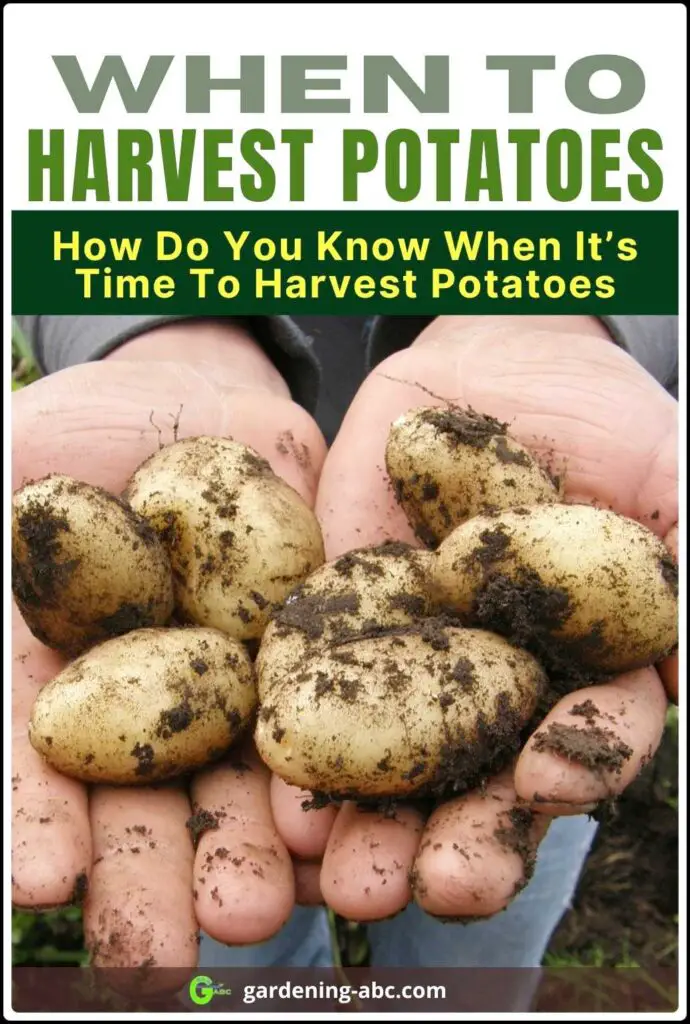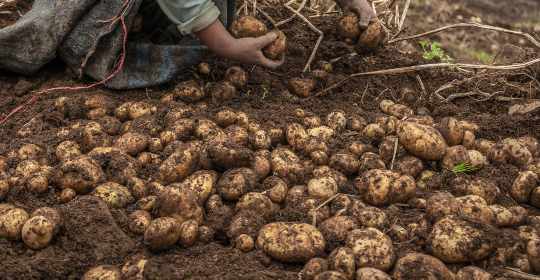We use affiliate links to run our site. When you buy through links on our site, we may earn an affiliate commission, without any added cost to you. Learn more
When people think about harvesting potatoes, they believe it is a complicated task. First, let me say that harvesting potatoes are neither complicated nor time-consuming. You just have to know how and get it done efficiently.
In this post, I will give you each and every detail related to potato harvesting.
So let’s get started…
When to Harvest Potatoes:
Harvesting potatoes at the right time is important because it allows you to enjoy the best flavor and texture from your crops. If harvested too early, your potatoes will be small and might not taste as good.
If harvested too late, your potatoes might have started to rot in the ground, or they could be sprouting. Potatoes can also start to green on the outside if left in the ground for too long.
The right time to harvest your potatoes depends on what type of potato you’ve planted. Different varieties have different harvest times, ranging from 80 days to 140 days after planting them in warm soil.
Harvesting potatoes on a sunny day is fine but if it’s rainy or wet outside, hold off on digging them up until it dries out.
How do you know when it’s time to harvest potatoes?
You can determine when they are ready by digging up a few plants and checking the size of their potatoes. In general, you should wait until the vines start turning brown before digging up all of the potatoes from each plant.
The best time to harvest is when the plant tops have died down. This reduces the risk of disease and damage to the potatoes.
Observe the foliage of your plants over several weeks, and wait until the tops start to look tired and dull. When more than half of the leaves have died back, it’s time to harvest.
If you need a few potatoes before then, knock or dig carefully to expose just a few tubers.
Do potatoes have to flower before harvesting?
The basic rule for harvesting potatoes is to wait until the plants have flowered, then give them another two weeks.
There are a couple of problems with this approach. First, there’s no guarantee that your plants will flower – in fact, it’s quite likely they won’t.
Second, the tubers will continue to grow after flowering, which means you might end up with very large potatoes indeed if you leave them in the ground too long.
The real trick to harvesting potatoes is to find a happy medium between those two concerns.
Can you harvest potatoes too early?
If you harvest your potatoes too early, they will have an unpleasant taste and texture because they will not have had time to fully develop.
If you wait until the vines have begun to die back, then you can be sure that your potatoes have had enough time to grow large and delicious.
How many potatoes do you get per plant?
This depends on a number of factors including soil fertility, variety, growing conditions, and how many tubers are left in the ground when harvested.
Generally, you can expect around 10-15 spuds from one seed potato and between 3-5lbs of maincrop potatoes per plant
Why are my potato plants falling over?
Usually, if your plants are falling over, most of the time it means the plant’s life cycle is finishing up and it’s time to harvest. This is especially the case if the plant is having yellow or brown leaves.
But sometimes there are other reasons for a potato plant to fall over. We discussed this in detail here. make sure you check that out before coming to any conclusion.
When should I stop watering my potato plants?
Potatoes need moisture to grow their tubers but may rot if they are not allowed to dry out occasionally.
Toward the end of the growing season, stop watering your potato plants and allow them to dry out for about two weeks before harvesting.
This will make them easier to dig up.
What happens if you don’t harvest potatoes?
If you don’t harvest them, they will die back completely and new potatoes won’t grow from the plant. So it’s best to get them out of the ground before this happens.
As long as your potatoes have flowered and produced good-sized tubers, they can be harvested at any stage while they’re still alive – even as tiny nubs or small new potatoes.
If you wait too long and all of the foliage has disappeared, it will be difficult to tell where the plants are without digging all over your garden!
How long can potatoes stay in the ground?
It depends on how cold it gets in your area. When temperatures drop below freezing, they can cause frost damage to potato tubers. But if that doesn’t happen where you live, then potatoes can pretty much be left in the ground indefinitely.
Potatoes can stay in the ground for a long time and still be good to eat. In fact, the best way to store potatoes for the longest possible time is to just leave them in the ground. Mulch them well with straw or leaves so that they don’t freeze during the winter.
How Long Does It Take To Harvest Potatoes?
Harvesting begins about three months after planting and can last for up to a month, depending on the type of potato planted. A good rule of thumb is to wait until the plants die down or have begun to dry out before you start harvesting.
Do potatoes keep growing after the plant dies?
Potatoes will not grow after the plant dies, but the skin will harden. If you harvest too early you’ll miss out on a lot of potatoes. leave the potato tubers for a week or two after the plant died and then harvest.
How to Harvest Potato Tubers:
There are two types of potatoes that we harvest,
- New potatoes
- Mature potatoes
The first is to harvest some “new potatoes,” which are simply young potatoes that are dug up before the plant is mature. They tend to be smaller and have thin skin, and you don’t want to store them for very long.
For new potatoes, use a garden fork or trowel to dig up the plants about three weeks after flowering. While you’re at it, check for potato bugs or other pests. The plants themselves can be composted, or even used as mulch around other plants that need some shade.
The second way is to harvest mature potatoes. Wait until the plant’s foliage has yellowed and died before harvesting mature potatoes.
You’ll get larger, more fully-developed spuds, but they won’t last as long in storage as they would if they were left in the ground longer — up to six months longer!
But don’t wait too long: frost will damage them (mature potatoes can survive a light frost).
Potatoes are usually dug up by hand with a garden fork or spade. Avoid cutting into tubers with a tool as you do not want to cut open any of the potatoes.
The skin on new potatoes is very thin, so be gentle when harvesting them. Smaller tubers can also be shaken loose from the soil by firmly grasping the stem (while wearing gloves), and shaking it gently with a side-to-side motion. This will release any tubers growing near the stem.
How To Dig Up Potatoes Without Damaging Them:
When you first harvest potatoes, they will have skin that is very fragile. This skin protects the potato during storage, so it’s important not to damage it. If you do, bacteria can enter the potato and rot it.
The most important part of harvesting potatoes is to make sure you don’t damage the crop or cut them with a shovel. Carefully dig around the plant before lifting it out of the soil. You can also use your hands to gently reach into the soil and loosen the dirt around the potatoes.
How Often Do You Harvest Potatoes?
When harvesting potatoes, dig up your entire potato crop at once. It’s better to wait than to dig them up as you need them.
If you harvest only a few at a time, the rest of the potatoes may be prone to invasion by pests and diseases and will not store as well.
Can you eat potatoes right after harvest?
It’s best to let new potatoes cure for a few days before eating them. Curing helps heal any cuts or scrapes that may have occurred during harvest time and allows the skin to set so it’s tougher and less prone to bruising.
You can eat new potatoes straight from the garden without curing, but their shelf life will be cut in half.
Why are my homegrown potatoes so small?
Growers often find that their first crop of potatoes each year is smaller than subsequent ones. This may be because they aren’t watering the plants enough during early growth.
Here is a detailed discussion on this topic.
Should you wash freshly dug potatoes?
Don’t wash your potatoes after harvesting. moisture can cause a lot of trouble for your potatoes. Gently brush off the dirt and store them.
wash the potatoes only at the time of cooking.
What To Do With Potatoes After Harvesting
Once harvested, your potatoes need to cure for about 10 days to two weeks before eating them. During this time, the skin will thicken and help prevent bruising during storage.
How To Cure Potatoes After Harvesting:
The first step in curing potatoes is to allow them to dry out for a day or two before storing them. This should be done in an area with good air circulation and a temperature of 60-70 F. (15-21 C.).
The ideal humidity would be around 85 percent but if it’s not that high, don’t worry about it too much. If you are using a curing basket or crate, make sure there is little or no light coming through it and that it has good air circulation.
The light can cause your potatoes to turn green, which makes them bitter and inedible, and poor air circulation can lead to mold growth.
Curing helps potato skin to thicken up so the potatoes can be stored longer. It also cures any minor cuts or nicks in the skin, which helps prevent disease build-up during storage.
Storing Potatoes for Long Term:
If you plan on storing your harvest for a while before eating it, keep the following tips in mind:
Don’t wash your potatoes before putting them in storage. Washing will increase their chances of rotting.
Store your potatoes in a cool, dark, and well-ventilated place.
Cure new potatoes by exposing them to sunlight for a week or two after harvesting, as this will help make their skin tougher and last longer in storage.
Conclusion:
Now you know everything about harvesting potatoes. Hopefully, by following these simple steps and tips your harvest will be a bountiful one, with only very little work involved.
You can learn more information about growing potatoes here.
If you like the post share it with others, and Don’t Forget to PIN IT.

Amazon and the Amazon logo are trademarks of Amazon.com, Inc, or its affiliates.

Hi there! My name is Prasenjit and I’m an avid gardener and someone who has grown a passion for growing plants. From my hands-on experience, I have learned what works and what doesn’t. Here I share everything I have learned.
